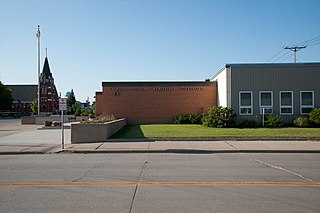
Cavalier County is a county in the U.S. state of North Dakota. It is south of the Canada–US border with Manitoba. As of the 2020 census, the population was 3,704. Its county seat is Langdon. The city of Cavalier is in nearby Pembina County.

North Dakota State University is a public land-grant research university in Fargo, North Dakota. It was founded as North Dakota Agricultural College in 1890 as the state's land-grant university. As of 2021, NDSU offers 94 undergraduate majors, 146 undergraduate degree programs, 5 undergraduate certificate programs, 84 undergraduate minors, 87 master's degree programs, 51 doctoral degree programs of study, and 210 graduate certificate programs. It is classified among "R1-Doctoral Universities – Very High Research Activity".
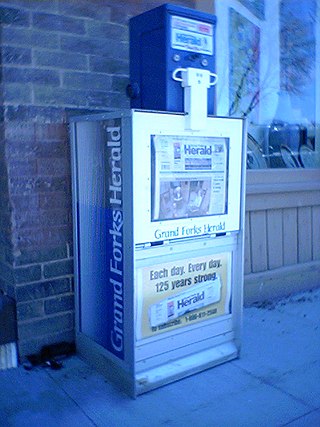
The Grand Forks Herald is a daily broadsheet newspaper, established in 1879, published in Grand Forks, North Dakota, United States. It is the primary daily paper for northeast North Dakota and northwest Minnesota. Its average daily circulation is approximately 7,500, in the city of Grand Forks plus about 7,500 more to the surrounding communities. Total circulation includes digital subscribers. It has the second largest circulation in the state of North Dakota.

The Masonic Block in Fargo, North Dakota, also known as Dakota Business College or Watkins Block, is an Early Commercial style building built in 1884. It was designed by Fargo architects Daniels & Proctor.
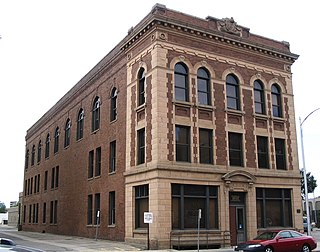
The Grand Lodge of North Dakota, Ancient Order of United Workmen is a building in Fargo, North Dakota, that was built in 1914 in Early Commercial style. It was designed by architects Haxby & Gillespie. Also known as the Fossum Building and as Interstate Business College, it was listed on the National Register of Historic Places in 1979.

Casselton Commercial Historic District is a 9.3-acre (3.8 ha) historic district in Casselton, North Dakota that was listed on the National Register of Historic Places in 1982.

Dibley House, also known as Graf House, is a property in Fargo, North Dakota that was listed on the National Register of Historic Places in 1980. The listing included two contributing buildings on an area of less than 1 acre (0.40 ha). The listing included two contributing buildings on an area of less than 1 acre (0.40 ha).

North Dakota State University District is a 36-acre (15 ha) historic district on the campus of North Dakota State University, in Fargo, North Dakota, that was listed on the National Register of Historic Places in 1986.
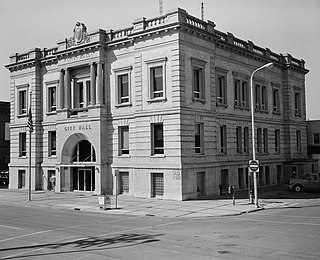
John W. Ross (1848–1914) was the first licensed architect in Grand Forks, North Dakota.

Grand Forks City Hall is a building in Grand Forks, North Dakota that was listed on the National Register of Historic Places in 1982.
Fargo Bridge & Iron Co. was a bridge company based in North Dakota in the early part of the 20th century.

The Western Fraternal Life Association, previously known as Zapadni Ceska Bratrska Jednota is a fraternal benefit society and financial services organization in the United States. The association has its roots in the Czechoslovak immigrant community of the 19th century. It was once the second largest Czech-American freethought fraternity in the United States.
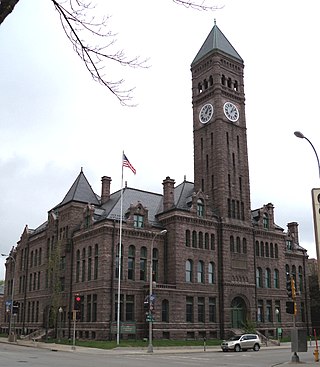
Wallace L. Dow (1844-1911), often known as W. L. Dow, was an architect of Sioux Falls, South Dakota. He has been referred to as the "Builder on the Prairie" and was "considered the premier architect of South Dakota in the late 19th century."

The Hebron Village Historic District encompasses the heart of the small town of Hebron, New Hampshire. The district was listed on the National Register of Historic Places in 1985. Multiple buildings of the district were added to the New Hampshire State Register of Historic Places in 2016.
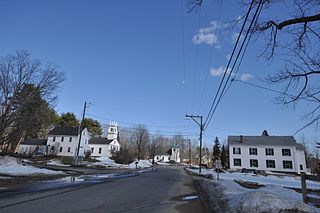
The Deerfield Center Historic District encompasses the heart of the rural New Hampshire town of Deerfield. It extends northwest along Church Street from its junction with North Road, Candia Road, and Raymond Road. It includes many of the town's municipal buildings, as well as a church and private residences, most of which were built before about 1920. The district was listed on the National Register of Historic Places in 2002.

Bristol Town Hall, at 45 Summer Street, is the town hall of Bristol, New Hampshire. It is a single story Greek Revival structure, built in 1849, and was the town's first purpose-built town hall. It continues to serve as a municipal meeting and polling place, although town offices are now in a modern building on Lake Street. The building was listed on the National Register of Historic Places in 2015.

Reading Town Hall, the town hall of Reading, Vermont, is located at the junction of Vermont Route 106 and Pleasant Street in the village of Felchville. Built in 1915 as a gift from a native son, the barn-like structure is a fine local example of Colonial Revival architecture, and has been a center of local civic activity since its construction. It was listed on the National Register of Historic Places in 1996.

The Armstrong Memorial Building is a historic municipal building at 3 North Lowell Road in Windham, New Hampshire. Built in 1899, it was the town's first purpose-built library building, a role it played until 1997. It now houses the town museum. The building was listed on the National Register of Historic Places in 2018.

St. George's Episcopal Memorial Church, a historic Episcopal church in Bismarck, North Dakota's capital, is unique for its construction incorporating stained glass from English churches bombed in World War II into its own stained-glass windows. It is located in the Episcopal Diocese of North Dakota and was added to the National Register of Historic Places in 2021. The building, completed in 1949, replaced an early one dating to 1881 in the Dakota Territory, prior to statehood in 1889. The original building was built on railroad-donated land in the first decade of the city's growth. The church needed more space by the 1930s but was unable to erect a larger building until after World War II. The original building was moved and repurposed as a museum at Camp Hancock State Historic Site. The newer building is notable for being constructed of pumice concrete and its unique stained-glass windows. The windows were made in England by Barton, Kinder, and Alderson, and the majority of them contained pieces of glass that were salvaged from dozens of damaged churches in southeast England during World War II. The glass studio documented the lineage of each window, with some made with glass collected from churches built in the Middle Ages.



















